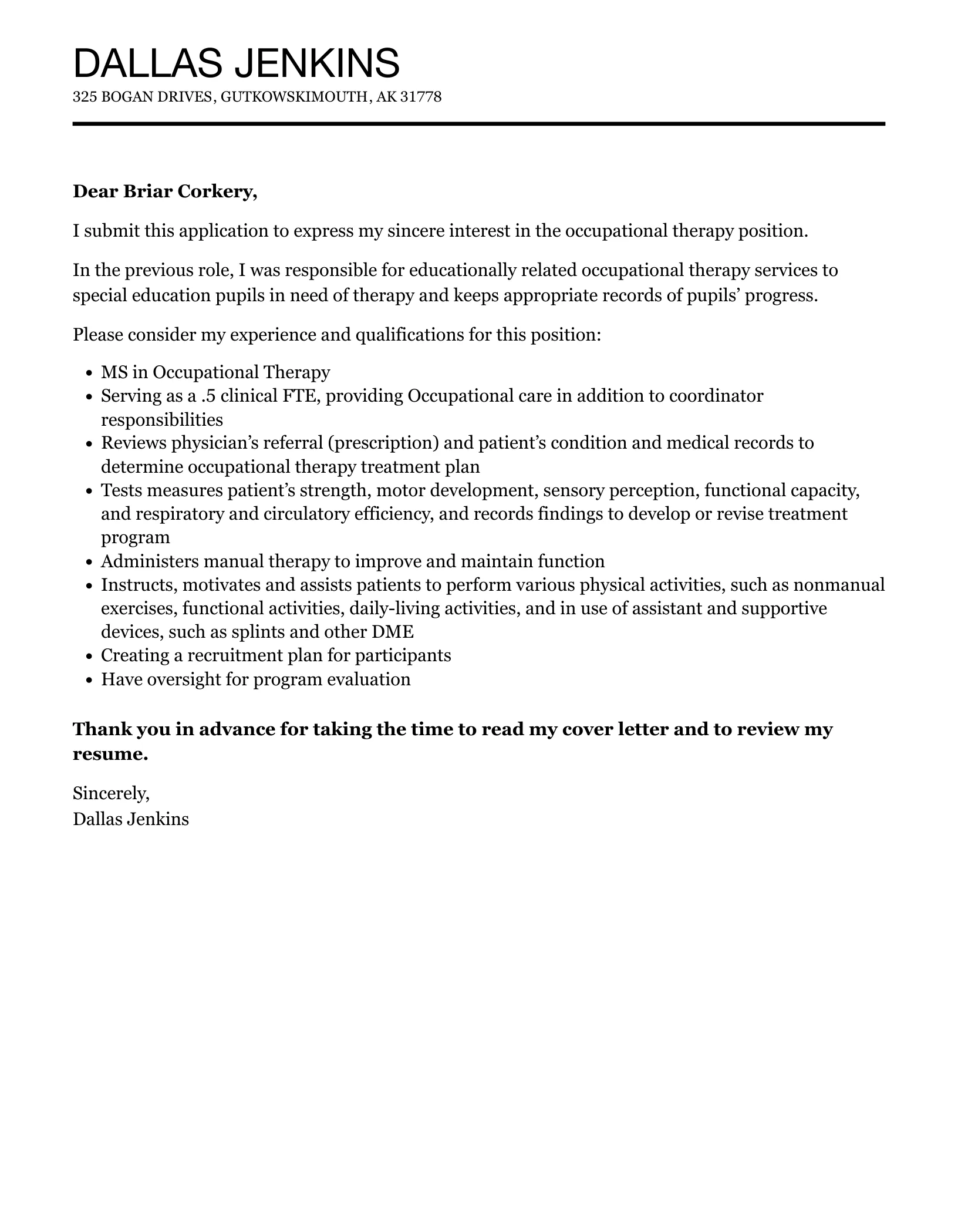Crafting a School-Based Occupational Therapy Cover Letter
A school-based occupational therapy cover letter is your first introduction to a potential employer and a critical step in securing your dream job. It’s not just a formality; it’s a carefully crafted document designed to showcase your skills, experience, and passion for helping children succeed. A well-written cover letter complements your resume, providing context and depth to your qualifications. It allows you to connect your experiences to the specific needs of the school, demonstrating that you’re the right fit. Think of it as your chance to make a strong first impression, setting the stage for an interview and ultimately, the opportunity to positively impact young lives. The goal is to go beyond simply listing your credentials; you must demonstrate why you are the perfect fit for this unique position. This requires a strategic approach, combining relevant information with a compelling narrative that highlights your suitability for the role.
Researching the School and Position
Before you start writing, thoroughly research the school and the specific occupational therapy position. Understanding the school’s mission, values, and student demographics is crucial. Visit the school’s website, read any available reports or publications, and look at their social media presence. This will give you insights into the school’s culture, programs, and the specific challenges faced by the students. When researching the position, carefully read the job description. Identify the key requirements and responsibilities, and take notes on the skills and experiences they are looking for. This information will be invaluable as you tailor your cover letter. Understanding the school’s needs and the specific requirements of the role will allow you to customize your cover letter, showing the hiring manager that you’ve taken the time to learn about the opportunity and are genuinely interested in the position. This effort demonstrates your professionalism and attention to detail, both of which are highly valued in any school environment. The more you know about the school and the position, the better equipped you are to create a cover letter that resonates with the employer.
Understanding the School’s Needs
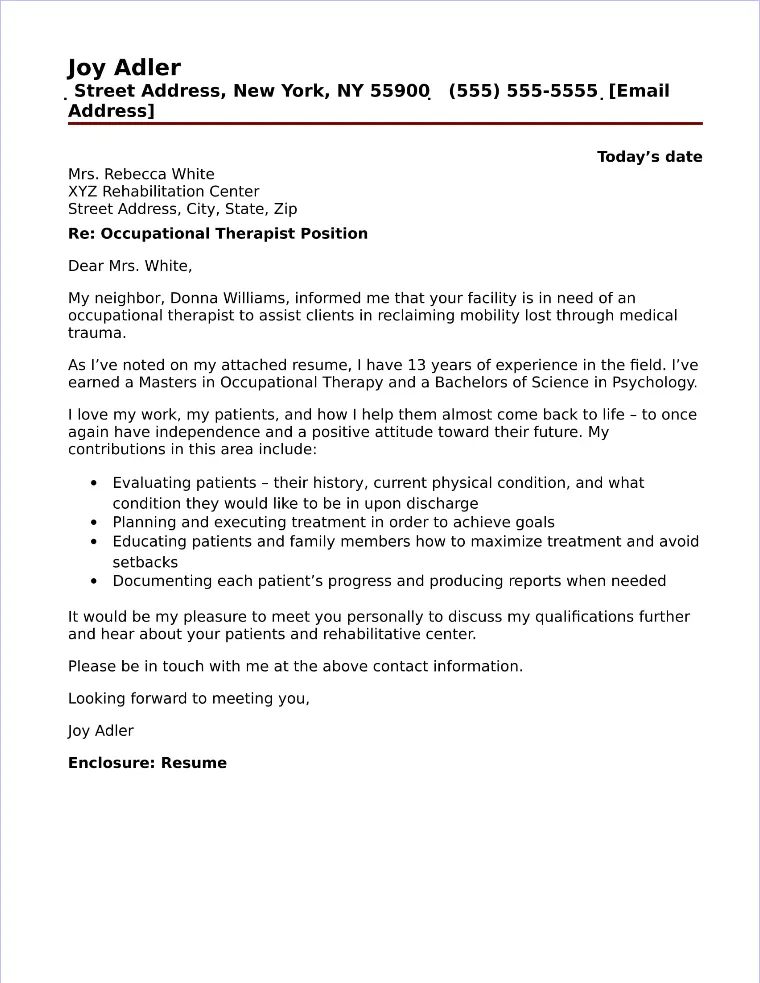
Delving deeper into the school’s needs involves more than just superficial research. Try to identify the specific challenges faced by the students, and consider how occupational therapy can address those issues. Does the school cater to students with specific disabilities or learning difficulties? Are there any particular programs or initiatives that focus on student wellness or development? Addressing these points in your cover letter immediately shows that you understand the environment and are ready to make a positive impact. Look for any information about the school’s strategic plans, special education programs, or any recent developments that could influence the role. Understanding these needs allows you to frame your skills and experience in a relevant and compelling manner. For example, if the school emphasizes inclusive education, highlight your experience with diverse student populations and your ability to adapt therapy techniques to meet individual needs. By demonstrating an awareness of their unique challenges, you position yourself as a proactive, thoughtful candidate who is likely to be a successful member of their team, showcasing a genuine interest in supporting the students and the school community.
Highlighting Relevant Skills and Experience
In your cover letter, it’s essential to highlight the skills and experiences most relevant to the school-based occupational therapy role. Focus on the skills and experiences that align with the specific job description and the school’s needs. Start by reviewing your past experiences and identifying instances where you successfully applied your skills in a similar setting. Quantify your achievements whenever possible, such as the number of students you’ve helped, the percentage improvement in their performance, or any successful interventions you have implemented. Emphasize your ability to assess students’ needs, develop individualized treatment plans, and collaborate with teachers, parents, and other professionals. Examples might include experience with sensory integration therapy, assistive technology, or classroom modifications. If you’ve worked with students with specific disabilities, like autism or ADHD, be sure to mention those experiences. Providing concrete examples of how you’ve applied your skills is far more effective than just listing them. This will help the hiring manager to visualize your potential contributions and how you can enhance the school’s existing programs.
Academic Qualifications and Certifications
Clearly state your academic qualifications and any relevant certifications. Begin by mentioning your degree in occupational therapy, the institution from which you graduated, and the year. Be sure to list any licenses or certifications required by the state or school district. This might include the National Board for Certification in Occupational Therapy (NBCOT) certification or state-specific licenses. Highlighting specialized certifications, such as those in sensory integration, feeding therapy, or assistive technology, can significantly increase your application’s appeal, especially if the school has specific needs in those areas. Include any continuing education courses or workshops you’ve completed, particularly those related to pediatrics, special education, or specific therapy techniques. These show your commitment to professional development and your knowledge of current best practices. Be specific and list the name of the certification, the certifying organization, and the date of completion. This ensures that your qualifications are easily verifiable and presents you as a serious, qualified candidate.
Experience in School Settings

School-based experience is highly valued, so be sure to emphasize any experience you have working in a school environment. Detail the specific schools where you have worked, your responsibilities, and the age groups you served. Even if your experience is limited, highlight any related experiences, such as fieldwork placements in schools, volunteer work with children, or internships in pediatric settings. If you have experience in the school system, be sure to mention this immediately. Describe any experience you have assessing children in educational settings, developing and implementing treatment plans, and collaborating with educators and parents. Provide examples of successful interventions you have performed and any improvements you observed in students’ performance or behavior. This practical experience directly demonstrates your familiarity with the unique challenges and rewards of working in schools. Quantify your accomplishments whenever possible, by providing figures such as the number of students you’ve supported, the percentage of students who met their goals, or any positive feedback you received from teachers or parents. These accomplishments demonstrate the value you would bring to the new position.
Adaptability and Collaboration Skills
School-based occupational therapy requires strong adaptability and collaboration skills. Schools are dynamic environments, and you must be able to adjust your approach based on the specific needs of each student and the demands of the school. In your cover letter, provide examples of how you’ve adapted your therapy techniques to suit different learning styles, cultural backgrounds, and physical environments. Describe your ability to work effectively with students of various ages, abilities, and personalities. Highlight your experience collaborating with teachers, parents, administrators, and other healthcare professionals. Give specific examples of how you’ve worked with a team to support a student’s success. Emphasize your communication skills, which are critical for effective collaboration. Be prepared to describe how you communicate complex information in a clear and concise manner, both verbally and in writing. Detail your experience creating and delivering presentations, leading meetings, or providing training to others. Your cover letter should demonstrate your ability to work well within a team, share information effectively, and adapt to various situations. This will illustrate your suitability and potential for long-term success in the school environment.
Showcasing Your Passion for Occupational Therapy
Your cover letter should clearly showcase your passion for occupational therapy and your commitment to helping children thrive. Express your enthusiasm for working with children and making a difference in their lives. Explain what draws you to the field of occupational therapy, and what motivates you to help students overcome challenges and achieve their potential. Share a personal anecdote or story that illustrates your dedication to the profession. This could be something about a student you’ve helped, a specific therapy technique you find rewarding, or your own inspiration to pursue occupational therapy. Connect your passion to the specific role. Show how your values align with the school’s mission and goals. For example, if the school focuses on inclusive education, express your commitment to providing equal opportunities for all students. Demonstrate your excitement about contributing to a positive, supportive learning environment. This genuine enthusiasm is often the deciding factor in securing an interview, so make sure your cover letter reflects your genuine passion for helping children achieve their goals.
Tailoring Your Cover Letter
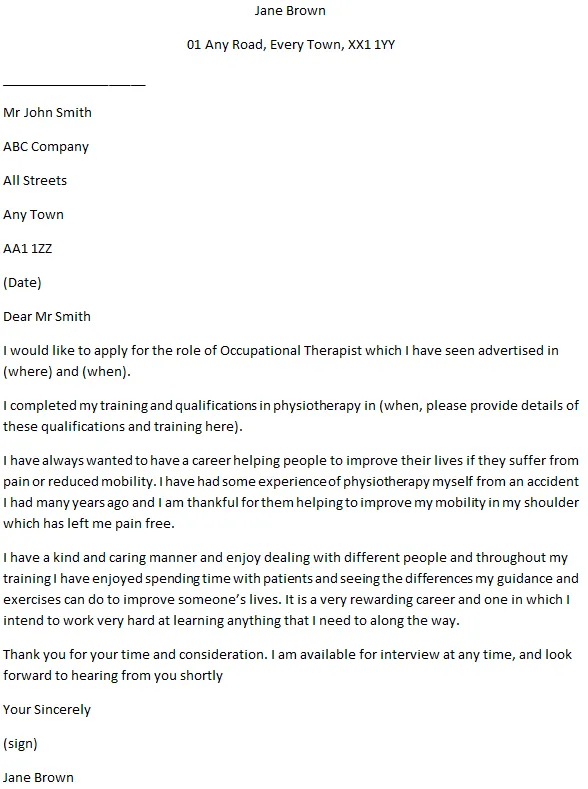
Avoid using a generic cover letter. Instead, tailor it to each specific job application. This demonstrates your interest in the position and shows that you’ve taken the time to understand the school’s needs and the specific requirements of the role. Start by personalizing the opening and closing of your letter. Address the hiring manager by name if possible (find it on the school’s website, or through a LinkedIn search). In the first paragraph, briefly state why you are excited about the opportunity and how your skills and experience align with the school’s mission. In the closing, reiterate your interest in the position and your enthusiasm for the opportunity to contribute to the school. Review the job description carefully and use keywords and phrases from it. Include examples of your experience that directly relate to the job requirements. Tailoring your letter significantly increases the chances that it resonates with the hiring manager and that they are impressed with your thorough preparation.
Customizing for Each Application
Beyond simply tailoring your cover letter, customize it to reflect the unique aspects of each job and school. Each school has a unique culture, and each role involves specific responsibilities. Show how your skills and experiences align with the school’s values. If a school emphasizes collaboration, highlight your experience working in teams and your ability to communicate effectively with teachers and parents. If a school has a specific focus on supporting students with autism, emphasize your experience working with autistic children. Review the school’s website and social media to understand its priorities and values. This demonstrates that you have done your research and that you are genuinely interested in the position. This customization is about more than just changing a few words. It’s about demonstrating that you fully understand the position, the school’s needs, and how you can contribute to their success. When you customize your application, you increase your chances of being perceived as a thoughtful, proactive candidate.
Emphasizing Achievements and Results
In your cover letter, move beyond listing your responsibilities; focus on your achievements and the positive outcomes you have produced. Use the STAR method (Situation, Task, Action, Result) to structure your examples and provide clear evidence of your impact. Describe the situation or challenge you faced, the task you were assigned, the actions you took, and the results you achieved. For example, if you improved a student’s fine motor skills, describe the initial problem, the interventions you implemented, and the measurable improvements in their performance. Quantify your achievements whenever possible, such as the percentage of students who met their goals, the number of IEPs you developed, or any positive feedback you received from parents or teachers. For instance, mention a specific project that enhanced student participation by a certain percentage. Achievements demonstrate your competence, while also showing you have the skills to make a real difference in the lives of students. This detail makes your achievements tangible and memorable.
Formatting and Structure
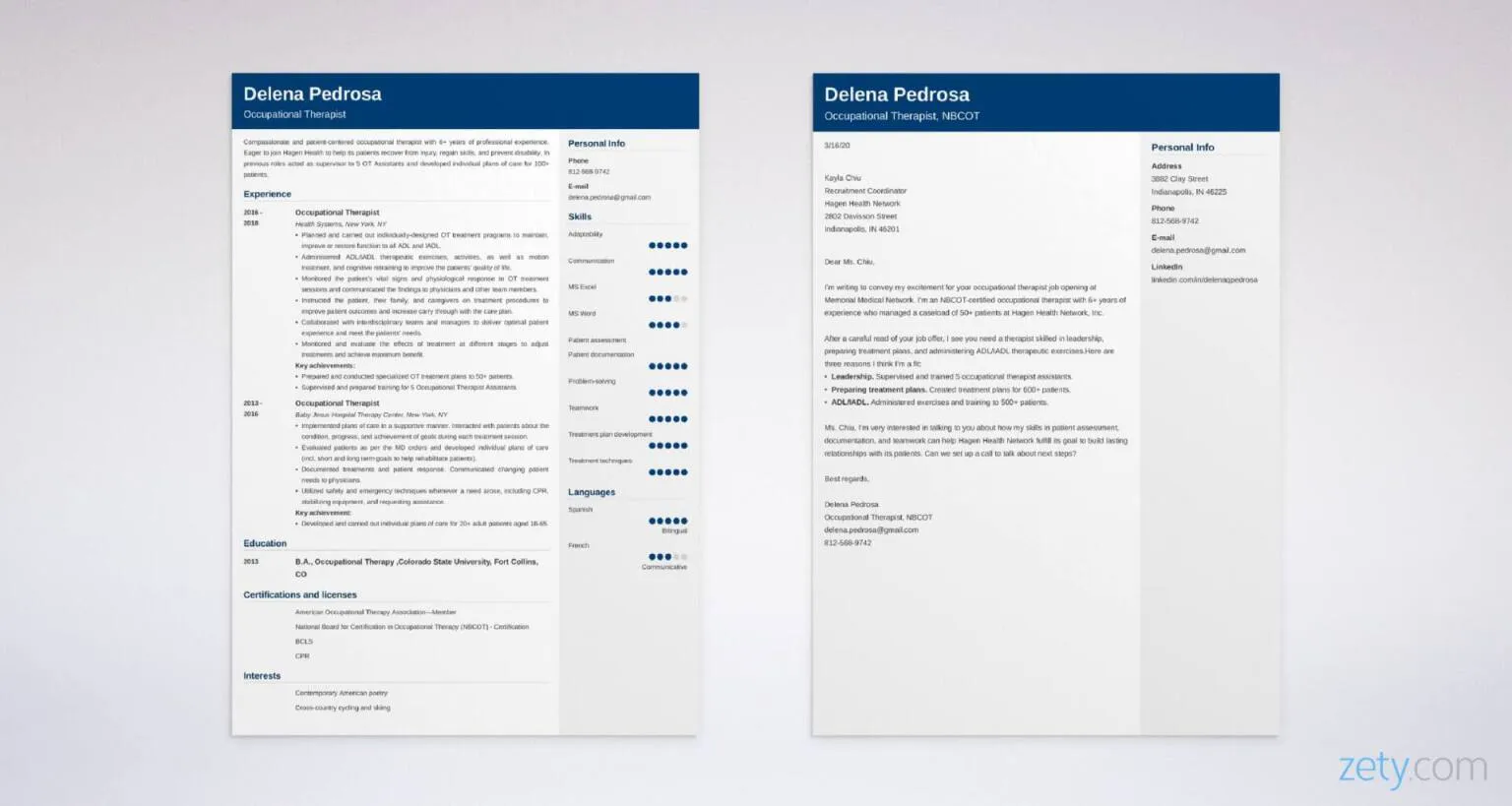
The formatting and structure of your cover letter are just as important as the content. A well-formatted letter is easier to read and more likely to make a positive impression. Use a professional font, such as Times New Roman, Arial, or Calibri, and keep the font size between 10 and 12 points. Ensure your letter is well-organized, with clear headings and subheadings to guide the reader. Use single spacing within paragraphs and double spacing between paragraphs to create visual breaks. Keep your paragraphs concise and use bullet points to highlight key information, making it easy for the reader to scan. Proofread the document multiple times to catch any errors in grammar, spelling, or punctuation. Consider having a friend or colleague review the letter as well. Be sure to include your contact information at the top of the letter. This includes your name, phone number, email address, and possibly your LinkedIn profile URL. These elements will ensure that your cover letter is professional, easy to read, and presents you as a detail-oriented candidate.
Creating a Professional Appearance
The appearance of your cover letter should be professional and polished. The letter should be printed on high-quality paper, or if submitted electronically, be saved as a PDF. This will ensure your formatting is preserved, and the document will be easily accessible by the hiring manager. Ensure the letter’s margins are consistent (typically 1 inch on all sides). Avoid using excessive formatting, such as bolding or underlining, which can make your letter look cluttered. Instead, use these elements sparingly to highlight important points. The overall goal is to create a visually appealing document that reflects your attention to detail and professionalism. Your cover letter’s professional appearance communicates that you value the application process and are dedicated to presenting your best self. This can make a subtle but significant difference when the hiring manager is considering your application.
Using a Clear and Concise Language
Use clear, concise, and direct language in your cover letter. Avoid jargon, overly complex sentences, or overly formal language. Your goal is to communicate your qualifications and your passion for occupational therapy in an easy-to-understand way. Use active voice whenever possible. Instead of saying “The intervention was implemented by me,” say “I implemented the intervention.” This makes your writing more direct and engaging. Focus on using strong action verbs to describe your skills and achievements, such as “developed,” “implemented,” “collaborated,” and “assessed.” This will make your letter more dynamic and professional. Keep your paragraphs short and to the point. Each paragraph should focus on a single idea or concept. Remember, the hiring manager is likely reviewing many applications, so you want to make sure your letter is easily digestible. Clarity is key in presenting yourself as an effective communicator.
Proofreading and Editing

Proofreading and editing are critical steps in the cover letter writing process, and should not be skipped. Errors in spelling, grammar, or punctuation can undermine your credibility and create a negative impression. After writing your cover letter, take the time to carefully proofread it. Read it aloud to catch any awkward phrasing or sentences. Use a grammar checker to identify potential errors. Consider asking a friend, family member, or career advisor to review your cover letter. They can often spot errors you may have missed. Pay close attention to details, such as the correct spelling of the school’s name and the hiring manager’s name. Make sure all formatting is consistent, and that the letter flows logically. Multiple revisions may be necessary to ensure your cover letter is error-free and well-written. Before submitting your application, ensure your cover letter is polished and professionally presented. A well-proofread letter demonstrates your attention to detail and your commitment to presenting yourself professionally.
The Closing and Call to Action
Your cover letter’s closing should leave a lasting positive impression and encourage the hiring manager to take the next step. Start by expressing your enthusiasm for the opportunity and restating your interest in the position. Summarize why you are a strong fit for the role, based on your skills, experience, and passion for occupational therapy. Make sure you thank the hiring manager for their time and consideration. Clearly state how you can be reached for an interview. Provide your phone number and email address again. Include a call to action, requesting an interview and stating your availability. For example, you can say “I am eager to discuss my qualifications further and would welcome the opportunity to interview at your earliest convenience.” A strong closing shows your engagement and helps advance your application. End your letter with a professional closing, such as “Sincerely” or “Best regards,” followed by your name.
Expressing Your Enthusiasm
Expressing your enthusiasm for the school-based occupational therapy position is one of the most crucial parts of your cover letter. Enthusiasm is infectious, and it shows you are genuinely excited about the opportunity. Use specific language to communicate your passion for the role and your commitment to the school’s mission and values. Connect your enthusiasm to the school’s specific needs. If the school is known for its inclusive environment, mention how excited you are to work with diverse student populations. If the school emphasizes collaboration, highlight your eagerness to work with teachers, parents, and other professionals. Be genuine. Share a personal anecdote or story that illustrates your passion for occupational therapy and your desire to make a difference in children’s lives. Make sure your enthusiasm is evident throughout the letter, from the opening paragraph to the closing. Your passion will set you apart from other applicants and enhance your chances of securing an interview.
Providing Contact Information
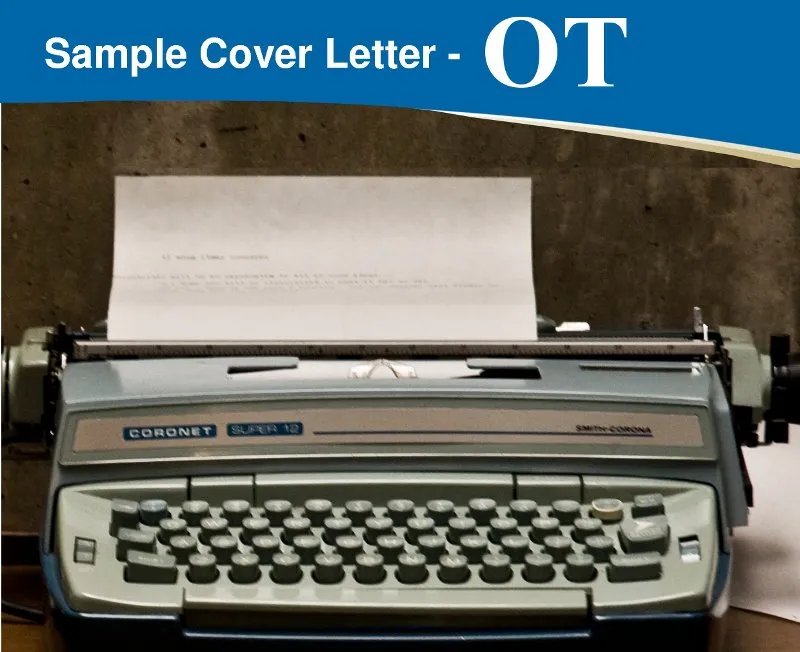
Make sure you provide your contact information clearly and accurately. This makes it easy for the hiring manager to reach you for an interview or to ask follow-up questions. Include your full name, phone number, and professional email address at the top of your cover letter and in the closing. Always use a professional email address. Avoid nicknames or informal language in your email address. Also, consider including a link to your LinkedIn profile. This allows the hiring manager to learn more about your professional background and qualifications. Double-check all contact information for accuracy. Nothing is more frustrating to a hiring manager than not being able to reach a candidate due to incorrect contact details. Make sure your phone number is active and that you have a professional voicemail message set up. Being accessible and responsive is essential to moving forward in the hiring process.
Follow-up Strategies
After submitting your cover letter and resume, it’s important to follow up. This demonstrates your continued interest in the position and helps you stay top-of-mind. Wait approximately one to two weeks after submitting your application before sending a follow-up email. In your follow-up email, briefly reiterate your interest in the position and your excitement about the opportunity. Thank the hiring manager for their time and consideration. You can also use this opportunity to reiterate any skills or experiences that make you a good fit for the role. Keep the email concise and professional. If you haven’t heard back after the follow-up email, you can send another email one to two weeks later. If you’ve been contacted for an interview, prepare thoroughly. Research the school and the interviewers, and prepare answers to common interview questions. Following these follow-up strategies shows that you’re committed to the opportunity and serious about the role.
Sending a Thank-You Note
Always send a thank-you note after an interview. This is a professional courtesy that reinforces your interest in the position and helps you stand out. Send your thank-you note within 24 hours of the interview. Send it via email, unless you’re instructed otherwise. In your thank-you note, thank the interviewer for their time and the opportunity to learn more about the position. Reiterate your interest in the role and highlight any key points from the interview. Remind the interviewer of your skills and experience. You can also mention something specific you discussed during the interview. Make sure your thank-you note is personalized and reflects your enthusiasm for the position. Thank-you notes help you build a relationship with the hiring manager, demonstrating your professionalism. It also reinforces your interest in the position.
Checking Application Status
When applying for a job, it’s crucial to periodically check the status of your application. This helps you stay organized and informed, and shows your enthusiasm for the role. If the school has an online application portal, log in to check for updates. If you haven’t received any updates within a reasonable timeframe, reach out to the hiring manager or the HR department. Be polite and professional. Ask about the status of your application and the expected timeline for a decision. This shows that you are proactive and invested in the hiring process. Maintain records of your application, including the date you submitted it, the job title, and any contact information. This will help you keep track of your applications and ensure you don’t miss any important updates or deadlines. Staying informed also helps you manage your expectations and decide when to follow up. It reinforces your interest and professionalism to the potential employer.
